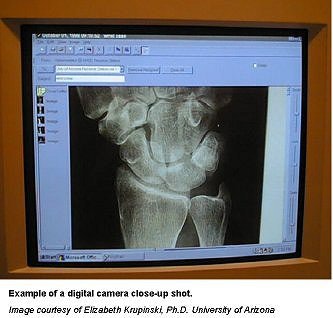

A research poster at last November's RSNA meeting in Chicago explored this new approach. Entitled "Observer Performance Evaluation of a Digital Camera for Acquiring Radiographic Images for Teleradiology," the study sought to determine if a commercially available, handheld digital camera could be used to acquire photographs of radiologic images to transmit over a telemedicine network.
The study was produced by Elizabeth Krupinski, a research associate professor at the University of Arizona in Tucson, who collected the data as part of her research with the Arizona Rural Telemedicine Network (ARTN).
Teleradiology on the ARTN saves time and feedback to referring clinicians: 85% of the teleradiology cases have a "wet read" report generated within six hours. However, some clinics either can't afford a film digitizer, or lack the teleradiology volume to justify purchasing one.
In the ARTN program, only 10% of all patient information transmitted for telemedicine consults consists of radiographs. Most consults are for neurology and orthopedics, Krupinski wrote.

Krupinski set out to explore the feasibility of using digital cameras as a low-cost alternative to film digitizers. In the study, 40 plain-film bone trauma cases (16 normal, 13 fracture, 5 sprain, 4 osteoarthritis, 2 foreign bodies) were photographed. These cases were representative of the type, typically subtle lesions, which required a consult in the past.
The camera used to acquire the images was a Canon PowerShot600. The camera was set at a pixel resolution of 832 x 608 for image acquisition, resulting in a typical file size of 150 KB -- ideal for transmission via standard dial-up telephone lines.
The attending physician at the rural clinic marked the region of interest (ROI) on the films. At least one global shot (from a distance of approximately two feet) and one close-up shot (from a distance of eight inches) were acquired for each image.
The images were then sent to the University of Arizona from a clinic in Patagonia, AZ, a distance of approximately 73 miles. Two radiologists and two orthopedic surgeons viewed the digital images on a CRT monitor set at a pixel resolution of 1600 x 1200. They also viewed the original film images on a standard viewbox. Krupinski measured diagnostic accuracy using receiver operating characteristic (ROC) techniques, and the physicians quantified their perceptions of image quality.

Krupinski's research found no significant differences in diagnostic accuracy (mean ROC Az = 0.9432 for film; mean ROC Az = 0.9243 for digital) between film and monitor readings of the images. Physician diagnostic confidence ratings were identical for both readings 43% of the time, differed by only one point 53% of the time, and differed by more than 2 points (significant disagreement) only 4% of the time.
Overall, images ranged in quality from good to excellent. The physicians rated nine of the photo cases as poor because the ROI was not captured sufficiently. They also rated four of the film cases as poor for similar reasons. Some readers also found both film and monitor views to be different from what they were accustomed to. Krupinski believes that further training in image capture techniques with a digital camera will solve these problems.
Krupinski concluded that the use of a handheld digital camera to capture images for secondary reads holds great promise for the ARTN. At a cost of less than $500 per camera, each clinic has been able to buy one without breaking its budget. Timeliness of reports has also seen dramatic improvement.
"Turnaround time for reports has been greatly improved, from up to 48 hours with film sent via courier to less than 24 hours with digital images," Krupinski wrote.
By Jonathan S. Batchelor
AuntMinnie.com staff writer
February 1, 2001
Related Reading
Finnish study finds that teleradiology improves diagnosis, treatment, December 1, 2000
Cable modems prove viable for teleradiology, June 6, 2000
Telemedicine systems experience demand, December 8, 1999
Click here to post your comments about this story. Please include the headline of the article in your message.
Copyright © 2001 AuntMinnie.com



















